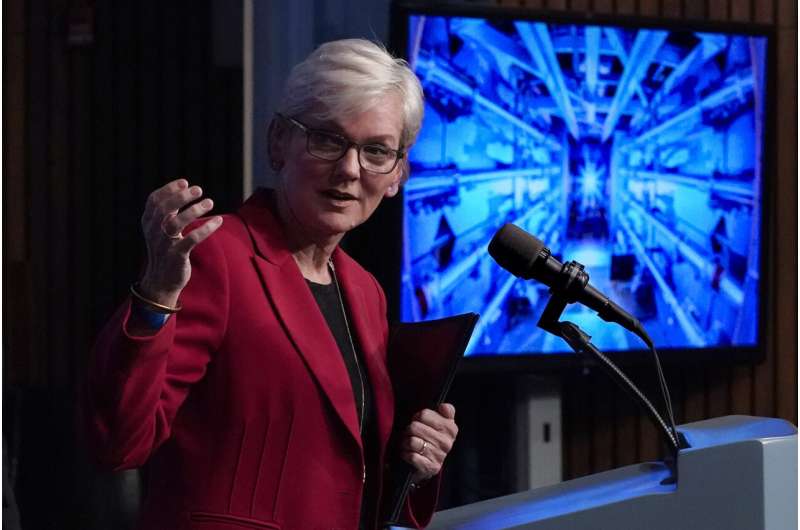Secretary of Energy Jennifer Granholm discusses a major scientific breakthrough in fusion research during a news conference at the Department of Energy in Washington, Tuesday, Dec. 13, 2022. Granholm worked the floor at CES to scout and tout the myriad opportunities for innovators, consumers and established business to spur the transition to clean energy. Credit: AP Photo/J. Scott Applewhite, File
Anyone wondering what compelled the U.S. Department of Energy's first-ever appearance this year at the CES tech show—traditionally an annual showcase for consumer gadgets—need only consider what its boss sees as her main mission.
Energy Secretary Jennifer Granholm showed up to tout and scout the myriad opportunities for innovators, consumers and established industries to benefit from last year's landmark legislation to remake the U.S. economy with cleaner, greener technologies. President Joe Biden has set goals of 100% clean electricity by 2035 and net zero emissions by 2050, and Granholm's job is to spearhead a monumental conversion to a new industrial paradigm.
The Associated Press spoke to Granholm at CES ahead of her passionate keynote on tax breaks available to spur the transition to clean energy. The interview has been edited for length and clarity.
Q: Let's start with the Biden administration's plans to increase the use of energy efficient tools.
A: An important component of the Inflation Reduction Act is consumer access to rebates and tax credits for energy-efficient appliances. Two that are really important: The heat pump, which is 48% more efficient, and there are tax credits and incentives for people to install those. And then there is the all-electric induction stove. There is so much to appreciate about induction stoves. And on top of their pro-climate energy efficiency and the tax credits as incentives for purchasers, there are also health reasons for them. (She cited a new report that says 12.7% of childhood asthma cases in the U.S. are attributable to gas stove use).
Q: The DOE under your leadership is very focused on getting money out the door to speed decarbonization. Is any of that on view at CES?
A: Yes, a ton of it. We have, for example, partnerships with companies including John Deere, which is moving to electrify farm equipment and even industrial equipment like backhoes for construction. And battery technologies, using not just lithium and graphite, carbon and cobalt but maybe sodium salts, iron or silica. There's also a push in consumer electronics to make televisions and other items more energy efficient.
Q: Does every company have a role to play?
A: All companies should be looking at how to conserve energy, how to reduce their greenhouse gas emissions -– whether it be through software or materials or in using renewable energy in their operations. One of the industries we have been trying to make more efficient is the nuclear industry.
Q: What about carbon credits?
A: Actually, we're not looking at putting a price on carbon. We've chosen a different policy route, which is to incentivize the deployment of clean tech and the reduction of energy use. But there is discussion of a carbon market related to imports.
Q: What ideas are perhaps not getting not getting traction that you think could really use funding?
A: There are two: First, I'm obsessed with enhanced geothermal. We've got the heat beneath our feet. It's clean. It's renewable. It is abundant. It has no waste. We should be lifting it up to spin turbines. To me, it's a missed opportunity. The oil and gas industry have expertise in it. They've used fracking to get to oil and gas. They should be using that same technology to extract the heat beneath our feet.
The second is long-duration storage, cracking the code on reducing the cost so that renewable energies become like baseload power that we can distribute. And then we are focusing on clean hydrogen, and we're excited about fusion now that we've had a big breakthrough there.
Q: Why is it important for the Department of Energy to be at CES now?
A: Electronics and technology are embedded in everything, including in all aspects of energy. We want to shore up our electric grid, make virtual power plants, have bi-directional charging of vehicles. All of that involves electronics. All of these companies here want to be able to pull down clean energy. So there is really a great synergy and no better time for us to be here. And we will be back.
© 2023 The Associated Press. All rights reserved. This material may not be published, broadcast, rewritten or redistributed without permission.























